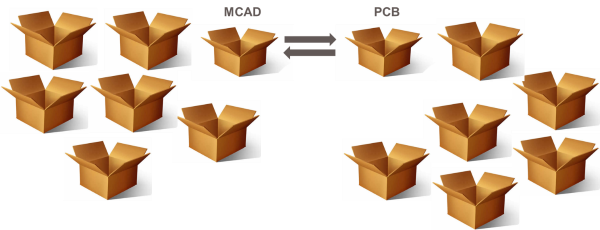Designing Smart Products: A Smarter Approach
Today many of our daily interactions involve connected devices and connectivity is shaping the economy. Gartner predicts that the total number of smart or connected “things” will reach 20.4 billion by 2020.
Designing smart products for the Internet of Things (IoT) and Industry 4.0 requires a smarter approach. In order to stay competitive business leaders need to assess their product development processes to ensure that they are striving for best-in-class performance. This includes keeping an eye on the ever-evolving state of product design tools.
Let’s look at the challenges involved in designing smart products
Adding electronics (“brains”) and connection (wireless, Bluetooth, etc.) to products greatly increases the complexity of the design process, production time, and ultimately the cost. Yet, a bigger challenge is the lack of collaboration between design disciplines involved in the product development process.
Electrical, mechanical, electronics and network engineers all use different product design tools, and the collaboration between departments is actually quite low tech as files are passed back and forth to find the best possible design.
In other words, your MCAD department doesn’t look like this old photograph, but it will fall behind if you don’t update your product design tools to provide greater collaboration between electrical and mechanical design teams.
For example, if your electrical design team is still using 2D drafting tools and Excel spreadsheets, it is time to assess the current state of mainstream ECAD and MCAD product design tools available today. Your teams need to be able to share data and ideas easier and quicker than ever before.
That’s the focus of our Automation Alley Tech Takeover event in Troy, Michigan on July 19th where Peter Bilello, President of CIMdata, and I will be talking about:
– Product development strategies that enable cross-functional teams to design smart products more efficiently with better quality and faster time-to-market
– Technology that companies use to reduce the complexity and cost of developing mechanical, electrical and electronic components that comprise smart products
– What best-in-class organizations are doing to keep their product development process nimble and efficient
According to Peter Bilello, “Manufacturers have much to gain from the business opportunity the IoT and Industry 4.0 bring. Now is the time to take a strategic look at product development processes and supporting technologies that will help them achieve their business goals today and well into the future.”
How best-in-class organizations are addressing design challenges
For my part at the Automation Alley event, I will share ideas on how best-in-class organizations are taking advantage of today’s technology to allow engineers and designers who work in different design domains, including electrical, mechanical and printed circuit board to collaborate and communicate more efficiently.
Releasing products both on time and on budget is no easy task. Outdated processes using STEP or IDF models begin an endless import/export process of design files.

How do you ever know if you have the latest design files, and what about all that lost data in each translation attempt when you end up with something that looks like this?

These are some of the reasons to join us at Automation Alley on July 19th to see how best-in-class organizations are honing their design processes to stay competitive—and more importantly to see how you can apply these same concepts to your design process.
If you missed the Automation Alley event, you can read CIMdata’s commentary summarizing the event and topics.
Related Articles
How to Handle Multi-Part Components in SOLIDWORKS Electrical
How SOLIDWORKS Electrical and PCB Get Rid of the Guesswork
About the Author
David Hofer began using Computer-Aided Engineering (CAE) tools in the late-1980’s doing embedded / FPGA programming, and Printed Circuit Board Layout. He began using SOLIDWORKS in 2011 while working on a high-speed imaging project. He joined Fisher Unitech in May of 2014 and now is the Electrical Technical Specialist. He is an Electronics NERD and loves to show people how to develop Electrical and Electronics designs using SOLIDWORKS products.

 Blog
Blog